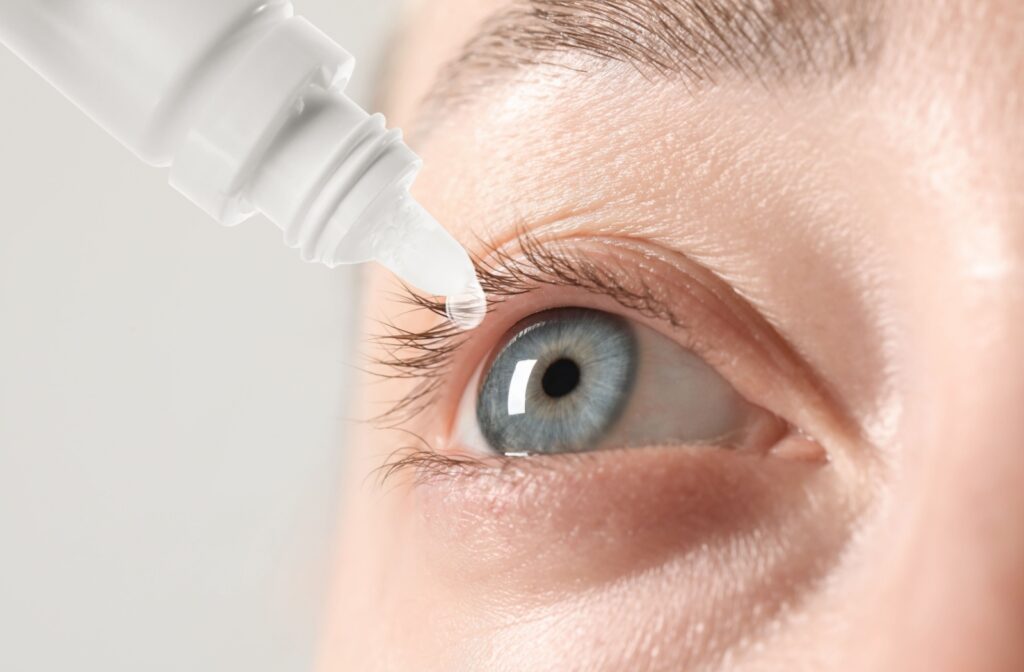Floaters and dry eyes can be distracting, bothersome, and, at times, worrying. They’re also both very common, so there’s a good chance you could have them at the same time.
However, dry eyes don’t cause floaters. While both conditions may affect your day-to-day life, and while they can happen simultaneously, they ultimately have different causes and require different treatments.
Understanding the distinction between these two eye concerns will help you better monitor your vision and decide when to seek professional care. Here’s what you need to know.
What Are Dry Eyes?
Dry eyes happen when your eyes don’t make enough tears or when your tears aren’t good enough to keep your eyes moist and comfortable. Tears are important for keeping your eyes healthy. When the balance of your tears is off, this can cause discomfort and other symptoms, such as:
- Burning, stinging, or scratchy feeling
- Feeling like something is stuck in your eye
- Red or irritated eyes
- Trouble with bright lights
- Blurry vision
- Sticky or stringy mucus around your eyes
- Watery eyes (a reaction to dryness which doesn’t typically bring relief)
Anyone can experience dry eyes. The condition can range from a small annoyance to something more serious. Some factors that can increase your risk of having chronic dry eyes include:
- Aging
- Hormonal changes
- UV exposure
- Certain medications like allergy pills or antidepressants
- Dry or windy environments
- Health conditions like Sjögren’s syndrome or autoimmune diseases
- Blinking less often, like when focused on screens
What Are Floaters?
Floaters are specks, squiggly lines, or cobweb-like shapes that appear to move across your field of vision. Much of the time they’re a simple annoyance. They result from changes within the eye’s vitreous gel—this is the jelly-like substance that fills most of the eyeball.
Tiny clumps of collagen fibers within the vitreous gel can cast shadows on the retina, the light-sensitive tissue at the back of your eye. Your brain interprets these shadows as floaters.
Floaters aren’t caused by dry eyes, but it’s understandable why the two get confused. Both can create visual disturbances, though these disturbances affect your vision differently.
Floaters are often harmless, but they can occasionally indicate a more serious issue. That’s why it’s crucial to keep track of their frequency and appearance. Some reasons you may be more likely to develop floaters include:
- Being very nearsighted
- Diabetes
- Cataract surgery
What Causes Floaters?
While dry eyes aren’t responsible for floaters, other factors may lead to their development. Floaters become more common as we age, because the vitreous gel inside our eyes naturally shrinks and changes consistency over time. Other, more serious causes, can include:
- Eye injury
- Eye infections or inflammation (e.g., uveitis)
- Internal eye bleeding
- Retinal tears or detachments
- Vitreous detachment
In some cases, even natural floaters can become bothersome if they make it hard to see clearly. Your optometrist may recommend monitoring them or, in rare cases, they consider more advanced treatments, such as a surgery called a vitrectomy.

When Should You Worry About Floaters?
Although floaters are common and usually harmless, certain changes may require immediate medical attention. You should contact your eye doctor right away if you experience any of the following:
- A sudden increase in the number of floaters
- Flashes of light in the same eye as the floaters
- Loss of peripheral vision or a dark shadow over your field of vision
- A gray curtain or large blurry areas obstructing your sight
These changes could be a sign of a serious eye problem, like a retinal tear or detachment, which needs quick treatment to protect your vision.
Tips for Managing Dry Eyes
While floaters may simply require some monitoring, dry eyes typically require a more direct approach. Depending on the cause, you can manage dryness with lifestyle changes or treatments.
If you’re looking to deal with mild dry eye at home or want to reduce your likelihood of developing it, here are some lifestyle tips you can use:
- Take breaks from screens: We blink a lot less when we use a screen—from 17 times a minute down to only 4 times a minute! Follow the 20-20-20 rule where you look at something 20 feet away for 20 seconds every 20 minutes to reduce eye strain and encourage blinking.
- Stay hydrated: Drink plenty of water to help maintain healthy tear production and overall eye comfort.
- Use a humidifier: Increase humidity indoors to combat dry environments and prevent tear evaporation.
- Wear protective eyewear outdoors: Protect your eyes from wind, dust, and harmful UV rays with wraparound sunglasses.
If you’re still struggling with dry eyes, your optometrist can suggest customized treatments to address the cause and help you find long-lasting relief. These treatments may include:
- Artificial tears: Over-the-counter, preservative-free eye drops can provide relief for mild symptoms.
- Punctal plugs: Tiny devices inserted into tear ducts help slow tear drainage.
- Prescription eye drops: Anti-inflammatory drops such as Restasis can improve tear production and quality.
Stay Proactive About Your Family’s Eye Health
Caring for your eyes is one of the best investments you can make in your overall quality of life. While dry eyes and floaters may not be directly related, both require attention and care to enjoy clear vision and comfort.
Whether you notice changes in your vision or you’re dealing with dry eyes, Willoughby Doctors of Optometry is here to help. From comprehensive eye exams for floaters to tailored treatment plans to handle dry eye syndrome, we’re passionate about keeping your eyes healthy and your vision clear. Book your appointment today!











